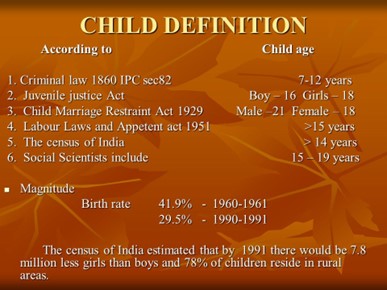PREVIOUS
Ambiguity in the Definition of ‘Child’
December 26 , 2023
415 days
483
0
- The parliamentary panel said that the country needs a uniform definition of ‘child’ under various laws.
- According to the Child and Adolescent Labour (Prohibition and Regulation) Act, 1986 (CALPRA), ‘child’ means a person who has not completed his fourteenth year of age or such age as may be specified in the Right of Children to Free and Compulsory Education Act, 2009, whichever is more.
- The amendment made to the Act in 2016 defines the child falling in the age group of (14-18) years.
- Under the Right of Children to Free and Compulsory Education Act, 2009, ‘Child’ means a male or female aged six to fourteen years.
- As per the Minimum Wages Act, 1948 vide its amendment in 1986 a ‘child’ is defined as a person who has not completed his fourteenth year of age.
- The Juvenile Justice (Care and Protection of Children) Act, 2015 defines ‘child’ as a person who has not completed eighteen years of age.
- The term ‘adolescent’ is not defined in JJ Act, 2015.
- The Rashtriya Kishore Swasthya Karyakaram defines an adolescent as a person between 10-19 years.
- The employment of children in contravention of the CALPRA Act is a cognizable offence, whereas under the JJ Act, 2015, it is a non-cognizable offence.

Leave a Reply
Your Comment is awaiting moderation.


